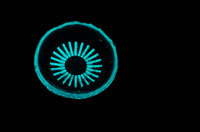Researchers at the California Institute of Technology (Caltech) have created a novel light therapy option: glow-in-the-dark contact lenses, designed to reduce the metabolic demands of the retina and, hopefully, reduce damage from diabetic retinopathy (DR).
 |
| This glow-in-the-dark contact lens could help reduce DR-related damage from nighttime rod cell metabolism. Photo: Caltech |
Caltech graduate student Colin Cook (MS '16) came up with the idea after realizing “rod cells, as it turns out, consume about twice as much oxygen in the dark as they do in the light," Mr. Cook said in a press release.
He and a team of researchers created contact lenses embedded with tiny vials in a radial pattern. The vials contain tritium, a radioactive form of hydrogen gas that emits electrons as it decays, providing light output for the lifetime of the contact lens, according to the press release.
The lenses provide the retinal rods with just enough light throughout the night to lower their oxygen consumption, and “if we turn metabolism in the retina down, we should be able to prevent some of the damage that occurs," Mr. Cook said.
He and his team feel the lenses overcome past hurdles that have made light therapy for DR a challenge, including eye movement that caused flickering from light masks. The lenses move with the eyes, eliminating any change in the light that could disrupt the wearers’ sleep.
So far, laboratory testing shows promise, “with rod cell activity reduced by as much as 90% when worn in the dark,” Mr. Cook said. Further testing is in the works to see if the changes in rod cell activity translate to reduced DR damage. From there, the researchers hope to seek FDA permits to begin clinical trials.
| Velasco E. Glowing contact lens could prevent a leading cause of blindness. Caltech. www.caltech.edu/news/glowing-contact-lens-could-prevent-leading-cause-blindness-82050. April 23, 2018. Accessed April 25, 2018. |

